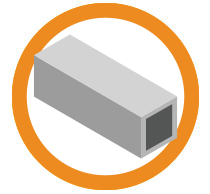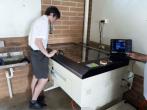
Painting is essential for children, because it aids in the development of mobility skills, stimulates their brains, and promotes improved focus and attention, but how is paint made?
Look around you, that liquid magic is everywhere! It covers your walls, your car and if you have kids - the masterpieces on the fridge... and probably their clothes too!
Life would be so bland without paint!
What Is Paint?
Paint is a mixture of four basic ingredients: pigments, resins, solvents, and additives.

Approximate composition of paint
Pigments are finely ground particles, which become the colour chemical in paint. They look a certain colour because they reflect some wavelengths of light and absorb others - you gotta love science!
Different compounds are used to create different colours. For example, titanium dioxide (a bright white chemical found in sand) is used to make white paint, iron oxide makes yellow, red, brown, or orange paint (think of rusty iron). Black comes from particles of carbon (think of burned toast). Different pigments are mixed together to make paint of any colour you can imagine.
The binder holds the pigment particles together and provides adhesion to the surface painted.
Solvent is the carrier that makes it all liquid-y, and evaporates as the paint dries. Water is the best-known and most versatile solvent we have and it's widely used in water-based paints (the name gives it away).
Additives provide specific performance characteristics, such as stain-blocking or mould-killing properties - neither of which are needed for a pre-schooler's masterpiece!
How is paint made?
Although there are many different varieties of paints, they are all basically made the same way.
First, the pigment is prepared. It might start off as a lump of rock, so it needs to be ground into a very fine powder. It may also need to be treated to change its colour. For example, it could be roasted to make it darker.
Once it has been ground to a powder, the pigment is mixed with the binder by a large machine that works like a giant food mixer. Solvent and additives are added as necessary.
It is essential that each sample of a particular paint looks exactly the same colour as every other sample. If the colour is not exactly right, the paint technician adds extra pigments. Extra solvents are added if the paint is too thick. Once the paint is the right color and consistency, it can be put into cans, bottles, tubes, or other containers.
What types of paint are available for education?
The four most common painting mediums used in schools are Tempera, Acrylic, Watercolor and Oil.
Tempera
Tempera Paint can be traced back to the Prehistoric era. Artists would take pigment and mix it into egg yolks to create vibrant colours. Modern science has taken the ancient tempera recipe to a more school and allergy friendly level by taking out the eggs and making it a “water-based tempera“.
Tempera paint is definitely recommended for younger students, because it is easy to use, washable, fast drying, and inexpensive.
Acrylic
Acrylic Paint is another modern twist on the egg-based tempera, combining pigment with synthetic polymers.
These paints are extremely versatile, and ideal for fine brushwork, staining, water media techniques and much more.
Our acrylic paints have excellent pigment quality, are quick-drying, and are very durable.
Also, they can be applied to almost any stable surface like watercolour paper or canvas.
Clean up is easy. Simply use water but make sure you clean thoroughly, this paint is permanent!
Watercolour
Watercolour has colour pigment suspended in water until the water dries and stains the surface. The paint brushes with fluidity and transparency and dries fairly quickly.
Using watercolour paper is essential, because it tends to stay more flat, be more workable and last longer.
It is perfect for any age level, and, because it is water-based, clean-up is simple.
Oil
You can probably guess the base of oil paint is, well, oil. It is a very durable paint, which provides a glossy-looking finish. Oil-based paint has long-lasting coverage and blends well with others.
Oil paint dries slowly, which can work to an artist's favour, because they can develop the painting gradually, making changes to the work along the way.
For students, using oil paints can be a great learning experience, but would better serve older children’s needs.
Oil paints can cause a lot of fumes, so make sure they are used in a well ventilated area.
Oil paints can be messy, so be sure to have your turpentine ready to clean, because water just won’t cut it.
Where can I get paint in Australia?
At Tools for Schools, we have all the paint and ink supplies your school could ever need. We have a massive range of non-toxic, Australian-made paint that is specifically designed for classrooms and use by children. Get in contact today, to discover how Tools for Schools can equip your school’s art room.







